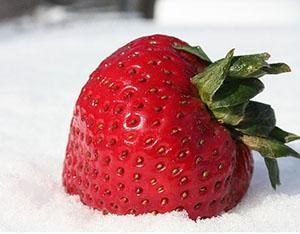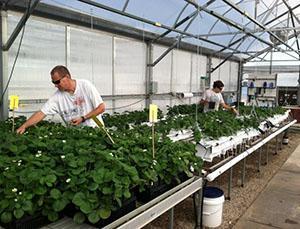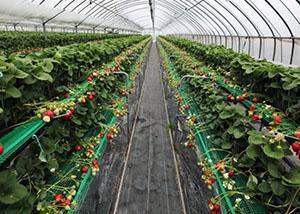Dutch technology for strawberries
 Fragrant strawberries in Russian beds have become a real symbol of the coming summer. But eating a domestic berry at other times of the year is unlikely to work. But in the malls all year round they offer products from Greece, Serbia, countries of northern Africa, the Mediterranean and Holland.
Fragrant strawberries in Russian beds have become a real symbol of the coming summer. But eating a domestic berry at other times of the year is unlikely to work. But in the malls all year round they offer products from Greece, Serbia, countries of northern Africa, the Mediterranean and Holland.
What technology for growing strawberries, even in areas where the climate cannot be called mild and warm, gives such good results?
Features of Dutch strawberry growing technology

- cultivation in heated greenhouses with controlled temperature conditions;
- plant feeding;
- creating a proper lighting and watering regime;
- competent selection of seedlings and maintaining its stock for renewal of plantings.
It is in the Netherlands that such a technology for growing strawberries in greenhouse most widely used. Local farmers supply most of Europe with berries, and forcing-based farming has become known as Dutch.
The complexities of strawberry cultivation technology all year round
 The berry culture bears fruit amicably with artificial lengthening of daylight hours and compliance with a special temperature and humidity regime. But it will not work to achieve a stable harvest if new bushes are planted at least once every two months. That is, the technology of growing strawberries all year round presupposes the presence of a serious stock of planting material. If large farms can buy seedlings, then it is more profitable for summer residents to grow them on their own.
The berry culture bears fruit amicably with artificial lengthening of daylight hours and compliance with a special temperature and humidity regime. But it will not work to achieve a stable harvest if new bushes are planted at least once every two months. That is, the technology of growing strawberries all year round presupposes the presence of a serious stock of planting material. If large farms can buy seedlings, then it is more profitable for summer residents to grow them on their own.
The experience of European and Chinese farmers shows that strawberry bushes obtained in the warm season, waiting for the moment of planting in the ground, can be stored at zero temperature for up to 9 months. And if we use modern repairing varieties, then planting will have to be updated only twice a year. To increase the efficiency of greenhouse areas strawberries are actively grown not only on the ridges, but also in all kinds of containers, bags and vertical structuresusing drip systems for irrigation.
Greenhouse lighting using Dutch technology
When using the Dutch technology for growing strawberries in a greenhouse, special attention is paid to additional lighting, in a spectrum close to sunlight. The luminaires are placed one meter above the plantings, and reflective materials are actively used to increase the lighting efficiency in the greenhouse.
 Strawberries respond well to an increase in daylight hours up to 12-16 hours:
Strawberries respond well to an increase in daylight hours up to 12-16 hours:
- plants can bloom within 10 days;
- the beginning of fruiting will be 35 days.
Additional lighting is effective in the morning and evening hours, but if the weather outside the greenhouse is cloudy, then the lamps can be left off.
Irrigation system based on strawberry cultivation technology in a greenhouse
 The drip system provided by this technology, whether it is surface or subsurface irrigation, does not allow moisture to get on the leaves and other parts of the plants, and all the water goes strictly as intended.
The drip system provided by this technology, whether it is surface or subsurface irrigation, does not allow moisture to get on the leaves and other parts of the plants, and all the water goes strictly as intended.
- This prevents the development of infections and diseases of the berry culture.
- Drip irrigation saves moisture and strength of the summer resident.
- Preheating the water for irrigation helps save energy and speeds up harvesting.
- Through the irrigation system, you can apply the necessary fertilizers and fertilizing under the strawberries.
Since water enters under the roots, the soil does not become waterlogged and does not dry out. And the subsurface system contributes to additional aeration of the soil under the plantings.
Soil preparation for strawberry seedlings
Intensive, all year long fruiting of plants is impossible without nutrient-rich soil.
Enterprises working on Dutch strawberry growing technology use a variety of substrates.
In suburban conditions, you can prepare a mixture of:
- loamy sod land, rich in organic matter, but having a slight acidity;
- sawdust moistened with a solution of urea, added for looseness at the rate of seven parts to two parts of the earth;
- glasses of wood ash, chalk or dolomite flour;
- low-lying peat, which absorbs and retains moisture well, and before adding copper sulfate impregnated with a solution with mullein to the mixture;
- humus from the decomposition of organic residues or manure;
- river coarse sand, introduced in the amount of 10% of the volume of the prepared mixture.
Before filling containers for planting strawberries, the substrate is well stirred, choosing foreign inclusions.
Microclimate in the greenhouse for forcing strawberries
 According to the technology of growing strawberries all year round, the optimal temperature range is from 18 to 25 ºС. Only at the moment of mass ejection of peduncles is it better to maintain the temperature up to 21 ºС.
According to the technology of growing strawberries all year round, the optimal temperature range is from 18 to 25 ºС. Only at the moment of mass ejection of peduncles is it better to maintain the temperature up to 21 ºС.
- Low temperatures inside the greenhouse can lead to prolonged flowering and poor harvests.
- An excessively high background adversely affects the ability of plants to pollinate and set berries.
 Strawberry bushes react extremely negatively to the temperature drop below 12 degrees and its rise to 35 ºС. The air humidity in the greenhouse must be maintained within 70–80%. If the air is dry, spraying is necessary. Excess humidity is reduced by ventilation.
Strawberry bushes react extremely negatively to the temperature drop below 12 degrees and its rise to 35 ºС. The air humidity in the greenhouse must be maintained within 70–80%. If the air is dry, spraying is necessary. Excess humidity is reduced by ventilation.
To accelerate the growth of seedlings and bring fruiting closer, experienced summer residents monitor the level of carbon dioxide in the greenhouse. To increase it to 0.1%, you can light candles.
Growing planting material
 You can prepare planting material for greenhouse cultivation of strawberries in different ways:
You can prepare planting material for greenhouse cultivation of strawberries in different ways:
- Young plants are grown on the mother plantation until late autumn, and with the arrival of frost, the rooted whiskers are carefully dug, cut off the foliage and stored with an open root system in cellars or basements at temperatures from 0 to +2 ºС. The day before planting in the greenhouse, the seedlings are removed from the storage for acclimatization and sorted. The advantage of this technology for growing strawberries is the root system developed in the seedlings, and the disadvantage is the need for large brood plantings, which also need to be updated in two years.
- Seedlings obtained by the cassette method are sent for storage at temperatures from 0 to +1 ºС and humidity of 95% in the form of young whiskers. Six weeks before being transplanted into the greenhouse, they are removed and planted in small containers of nutrient-rich soil. The containers are shaded for 4 weeks while there is intensive root formation. The plants are exposed to light in the fifth week, and in the sixth - they are planted in the greenhouse.
Planting strawberries in a greenhouse
 The Dutch technology for uninterrupted growing of fresh berries involves the use of a variety of containers for planting plants. These can be cut-out polypropylene pipes, pots and plastic bags and containers.
The Dutch technology for uninterrupted growing of fresh berries involves the use of a variety of containers for planting plants. These can be cut-out polypropylene pipes, pots and plastic bags and containers.
The main thing is that the containers placed vertically or in several tiers have a volume sufficient for the root system, and the plants receive the required watering and lighting.
One of the practical solutions is a plastic bag, up to 2 meters high, so that picking berries is simple and convenient, and with a diameter of at least 15 cm.After 25 cm, cross-shaped cuts are made on the surface of the bag with the substrate in a checkerboard pattern, where the seedlings are planted.
 When planting in boxes or containers, it is important that the plantation is not thickened and well ventilated. This will prevent a putrid infection from developing and will have a positive effect on the quality of the berry.
When planting in boxes or containers, it is important that the plantation is not thickened and well ventilated. This will prevent a putrid infection from developing and will have a positive effect on the quality of the berry.
The technology of growing strawberries all year round is good when using self-pollinating varieties of berries, otherwise the summer resident will have to pollinate with a brush, a fan, or, if space permits, put a hive in the greenhouse.
Despite the apparent hassle of such berry cultivation, the costs quickly pay off, since even in the cold season, up to 50 kg of fresh strawberries can be harvested from a square meter of the greenhouse.